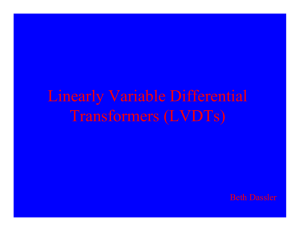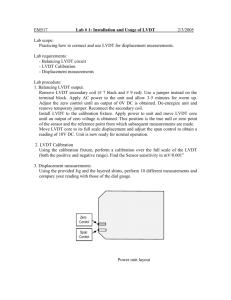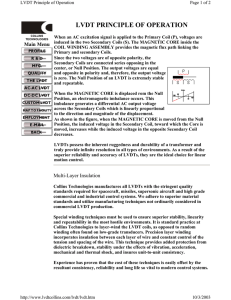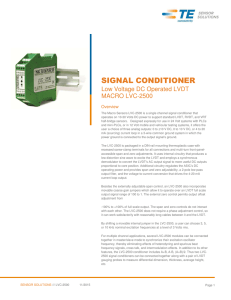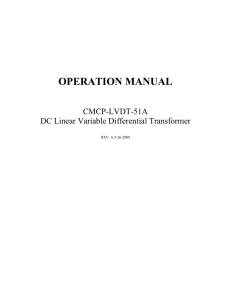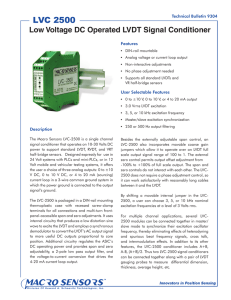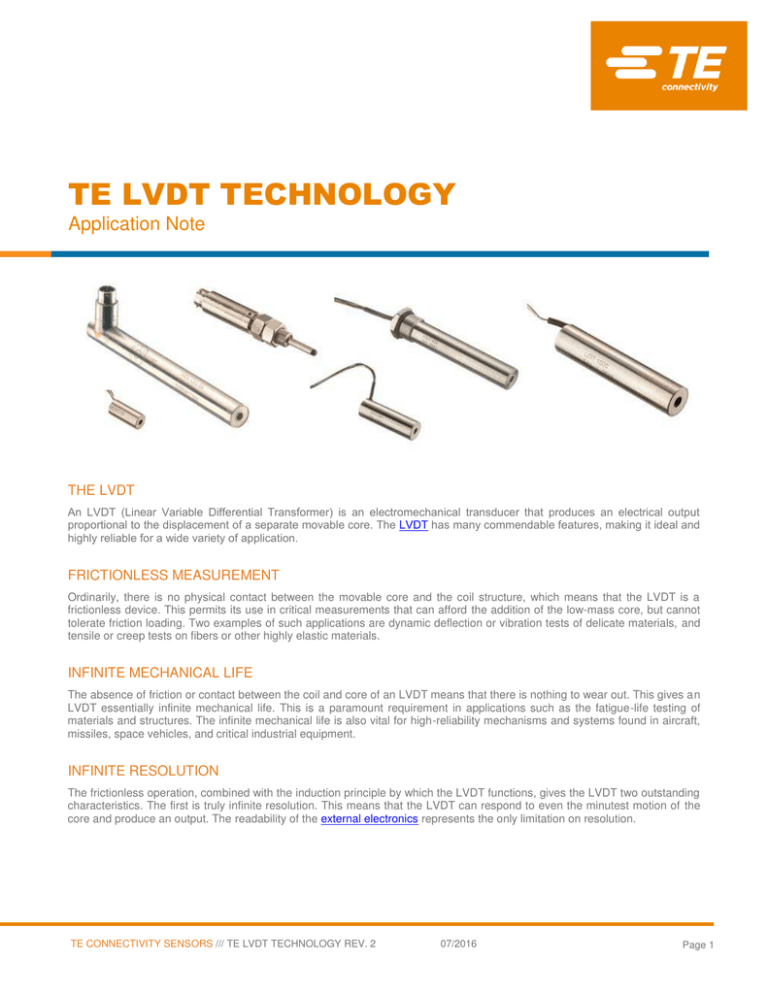
TE LVDT TECHNOLOGY
Application Note
THE LVDT
An LVDT (Linear Variable Differential Transformer) is an electromechanical transducer that produces an electrical output
proportional to the displacement of a separate movable core. The LVDT has many commendable features, making it ideal and
highly reliable for a wide variety of application.
FRICTIONLESS MEASUREMENT
Ordinarily, there is no physical contact between the movable core and the coil structure, which means that the LVDT is a
frictionless device. This permits its use in critical measurements that can afford the addition of the low-mass core, but cannot
tolerate friction loading. Two examples of such applications are dynamic deflection or vibration tests of delicate materials, and
tensile or creep tests on fibers or other highly elastic materials.
INFINITE MECHANICAL LIFE
The absence of friction or contact between the coil and core of an LVDT means that there is nothing to wear out. This gives an
LVDT essentially infinite mechanical life. This is a paramount requirement in applications such as the fatigue-life testing of
materials and structures. The infinite mechanical life is also vital for high-reliability mechanisms and systems found in aircraft,
missiles, space vehicles, and critical industrial equipment.
INFINITE RESOLUTION
The frictionless operation, combined with the induction principle by which the LVDT functions, gives the LVDT two outstanding
characteristics. The first is truly infinite resolution. This means that the LVDT can respond to even the minutest motion of the
core and produce an output. The readability of the external electronics represents the only limitation on resolution.
TE CONNECTIVITY SENSORS /// TE LVDT TECHNOLOGY REV. 2
07/2016
Page 1
LA TECHNOLOGIE LVDT DE MEASTM
APPLICATION NOTE
NULL POSITON REPEATABILITY
The inherent symmetry of the LVDT construction provides its second outstanding characteristic: The null position (zero)
repeatability. The null position of an LVDT is extremely stable and repeatable. Thus the LVDT can be used as an excellent null
position indicator in high-gain closed-loop control systems.
CROSS-AXIS REJECTION
An LVDT is predominantly sensitive to axial and relatively insensitive to radial core motion. This means that it can be used in
applications where the core does not move in an exact straight line; as, for example, when an LVDT is coupled to the end of a
Bourdon tube to measure pressure. This feature and others are unique to the LVDT. They arise from the basic fact that the
LVDT is an electrical transformer with a separable non-contacting core.
CORE AND COIL SEPARATION
The separation between the LVDT core and the coil permits the isolation of media such as pressurized, corrosive, or caustic
fluids from the coil assembly, by adding a non-magnetic barrier (pressure isolation vessel) interposed between the core and the
inside of the coil. It also makes the hermetic sealing of the coil assembly possible and eliminates the need for a dynamic seal
on the moving member. Only a static seal is necessary to seal the coil assembly within the pressurized system.
Many of our LVDTs incorporate this feature (i.e. HC Series; XS-C); TE Connectivity also designs and manufactures LVDTs with
separate media isolation vessels. Major applications are found in hydraulic systems (valves, actuators, reservoirs, etc.).
EXTREME ROBUSTESSE
The combination of the materials used in TE Connectivity LVDTs and the techniques we use for assembling them result in
extremely rugged and durable transducers. This rugged construction permits our LVDTs to continue functioning even after
exposure to substantial shock loads and high vibration levels often encountered in industrial environments.
ENVIRONMENTAL COMPATIBILITY
An LVDT is one of the few transducers that can operate in a variety of hostile environments. For example, a hermetically sealed
LVDT uses stainless steel, which allows exposure to corrosive liquids or vapors.
Certain situations call for LVDT operation in more extreme environments. It could be necessary to operate at cryogenic
temperatures, such as at the surface of liquid nitrogen; or within the primary containment vessel of a nuclear reactor, at
temperatures ranging up to 1,000°F (540°C) coupled with total integrated radiation of 10 11 Rads (109 Gray) and/or total integrated
neutron flux of 3 x 1020 NVT. TE Connectivity XS-ZTR is well suited for these applications. Yet another extreme environment is
the operation in fluids pressurized up to 20,000 psi (1,400 Bars).
Suitably designed LVDTs can be used in various combinations of these hostile environments. However, their life may be limited
by the severity of the operating conditions; this must be considered on a case by case basis.
INPUT/OUTPUT ISOLATION
The fact that the LVDT is a transformer means that there is complete physical isolation between the excitation input (primary)
and the outputs (secondary). This feature allows its use without the need for buffer amplifiers. It also provides galvanic isolation
between the signal and the excitation grounds for high-performance measurement and control loops.
CAPTIVE CORE OPTION
Many TE Connectivity LVDTs offer a captive core option that greatly simplifies installation. This option utilizes an assembly that
captures and guides the core within the LVDT. The assembly incorporates a PTFE sleeve over the core, a connecting rod, and
a stainless steel tube, providing low friction travel along the stroke length. A bronze bearing on the LVDT front end
accommodates lateral movement of the rod during operation while keeping the core inside the tube. The components of the
assembly are field replaceable.
TE CONNECTIVITY SENSORS /// TE LVDT TECHNOLOGY REV. 2
07/2016
Page 2
LA TECHNOLOGIE LVDT DE MEASTM
APPLICATION NOTE
HOW THE LVDT WORKS
The LVDT is an electromechanical device that produces an electrical signal proportional to the displacement of a separate
movable core. It consists of a primary coil and two secondary coils symmetrically spaced on a cylindrical form. The free-moving,
rod-shaped ferromagnetic core inside the coil assembly provides a path for the magnetic flux linking the coils.
When the primary coil is energized by an external AC source (excitation), voltages are induced in the two secondary coils. These
secondary coils are connected series opposing, therefore, the net output of the transducer is the difference between these
voltages which is zero when the core is at the center (null position). When the core is moved away from the null position, the
induced voltage in the secondary coil toward which the core is moved increases, while the induced voltage in the opposite coil
decreases. This action produces a differential voltage output that varies linearly with changes in core position. The phase of this
output signal changes abruptly by 180° as the core is moved from one side of null to the other. The core must always be fully
within the coil assembly during operation of the LVDT; otherwise gross non-linearity will occur and the coils could even overheat.
TE CONNECTIVITY SENSORS /// TE LVDT TECHNOLOGY REV. 2
07/2016
Page 3
LA TECHNOLOGIE LVDT DE MEASTM
APPLICATION NOTE
TE CONNECTIVITY LVDT DESIGN AND CONSTRUCTION
TE Connectivity has an extremely wide variety of LVDT types, sizes, ranges, and physical configurations commercially available.
Each series of LVDTs represents the culmination of several decades of refinement in the application of electromagnetic
principles as well as improved methods of construction.
A primary design consideration has been the determination of a combination of windings which produces excellent linearity
without compromising other desirable performance characteristics.
The personal computer has played a vital role in the refinement of these construction techniques. Today TE Connectivity uses
computerized winding machines and test stations. In addition, state-of-the-art materials are continually replacing more traditional
materials as they prove suitable for LVDT construction.
TE CONNECTIVITY SENSORS /// TE LVDT TECHNOLOGY REV. 2
07/2016
Page 4
LA TECHNOLOGIE LVDT DE MEASTM
APPLICATION NOTE
DC-OPERATED LVDT
The DC-LVDT maintains all of the desirable characteristics of the AC-LVDT, but has the simplicity of DC operation. It is
composed of two integral parts: An AC LVDT and a carrier generator/signal conditioning module. Small, yet rugged, the
electronic module eliminates most of the volume, weight, and cost of conventional external AC signal conditioning equipment.
The self-contained LVDT operates from a simple DC power supply or, in some cases, a battery. Virtually any DC meter can be
employed as readout. The output of the DC LVDT can either be a DC voltage or current loop (4 to 20mA).
As can be seen from the block diagram below, our electronic module operates from a DC power source. It is protected against
damage resulting from accidental misconnection to the wrong polarity of the power supply.
The carrier oscillator produces a constant amplitude sine wave to excite the primary of the LVDT. The sinusoidal excitation
provides superior performance to square waves.
With continuing advances in technology, the DC LVDTs are further refined to produce high performance, economical units. The
entire signal conditioning module, mounted in tandem with the LVDT, adds only slightly to the overall length of the transducer.
DIGITAL I/O LVDT
TE Connectivity LVDTs with direct digital output such as HC-485 or GC-485 eliminate the need for external analog to digital
conversion. The analog output is scaled into calibrated displacement engineering units (imperial or metric) by the internal
microprocessor, thus providing a traceable measurement without need of an on-site calibration.
The two-wire addressable RS-485 output supports the standard Modbus RTU, Modbus ASCII, Generic ASCII, and I-series ASCII
protocols. Internal MIN, MAX and TIR functions store peak and valley readings at a maximum update rate of 600 samples per
second to deliver the information to the host, on demand. An internal tare or zero function allows unipolar or bipolar output, as
the application dictates.
TE Connectivity has expertise to develop digital I/O LVDTs based on other protocols, such as CANopen.
POSITION TRANSMITTER SYSTEMS
In addition to the full line of AC and DC operated LVDTs, TE Connectivity offers 2-wire current loop position transmitter systems.
These loop powered transmitter systems are especially suited to valve position feedback and other position indication
applications for the process industry.
These systems consist of an LVDT or an RVDT with matching electronics (to be remotely located) to provide 4-20mA output into
a 2-wire loop. They allow remote sensing in applications in which local AC power is not readily available, or where the
temperatures are too high for sensor-integrated electronics.
CTS-420 Position Transmitter System
TE CONNECTIVITY SENSORS /// TE LVDT TECHNOLOGY REV. 2
07/2016
Page 5
LA TECHNOLOGIE LVDT DE MEASTM
APPLICATION NOTE
TE Connectivity offers many other types of sensors and signal conditioners. Data sheets can be downloaded from our web site:
http://www.te.com/usa-en/products/sensors.html
NORTH AMERICA
EUROPE
ASIA
Measurement Specialties, Inc.,
a TE Connectivity Company
1000 Lucas Way
Hampton, VA 23666
United States
Phone: +1-800-745-8008
Fax: +1-757-766-4297
Email: customercare.hmpt@te.com
MEAS Deutschland GmbH ,
a TE Connectivity Company
Hauert 13
D-44227 Dortmund
Germany
Phone: +49-(0)231-9740-0
Fax: +49-(0)231-9740-20
Email: customercare.dtmd@te.com
Measurement Specialties China Ltd.,
a TE Connectivity Company
No. 26, Langshan Road
High-tech Park (North)
Nanshan District, Shenzhen 518057
China
Phone: +86-755-33305088
Fax: +86-755-33305099
Email: customercare.shzn@te.com
te.com/sensorsolutions
Measurement Specialties, Inc., a TE Connectivity company.
Measurement Specialties, MEAS, American Sensor Technologies, AST, TE Connectivity, TE Connectivity (logo) and EVERY CONNECTION COUNTS are trademarks. All other logos,
products and/or company names referred to herein might be trademarks of their respective owners.
The information given herein, including drawings, illustrations and schematics which are intended for illustration purposes only, is believed to be reliable. However, TE Connectivity makes
no warranties as to its accuracy or completeness and disclaims any liability in connection with its use. TE Connectivity‘s obligations shall only be as set forth in TE Connectivity‘s Standard
Terms and Conditions of Sale for this product and in no case will TE Connectivity be liable for any incidental, indirect or consequential damages arising out of the sale, resale, use or misuse
of the product. Users of TE Connectivity products should make their own evaluation to determine the suitability of each such product for the specific application.
© 2016
TE Connectivity Ltd. family of companies
All Rights Reserved.
TE CONNECTIVITY SENSORS /// TE LVDT TECHNOLOGY REV. 2
07/2016
Page 6

